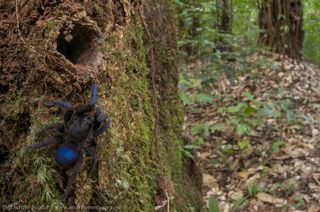Hairy, Blue Tarantulas Found Hiding in Hole-Filled Tree Stump

One dark night in the Guyana rainforest, herpetologist Andrew Snyder serendipitously shined his flashlight on "a small glint of brilliant, cobalt blue" sticking out of a rotting stump.
At first, Snyder thought the glint was coming from the eyes of a spider, which usually shine blue under bright lights. But that wasn't the case, he quickly realized. Rather, Snyder had come across a previously unknown species of tarantula with hairy, blue legs.
"I immediately knew that this one was unlike any species I have encountered before," Snyder, a doctoral student in the Department of Biology at the University of Mississippi and a photographer, wrote in a Global Wildlife Conservation blog. [In Photos: Tarantulas Strut Their Stuff]
Also astounding was the spider's hangout: a 5-foot-tall (1.5 meters) tree stump that was riddled with holes. It's unclear whether the tarantula made the holes, "but most, if not all, of the holes appeared to have its own tarantula residing in it," Snyder told Live Science.
The discovery was part of a monthlong survey in March 2014 known as the second Biodiversity Assessment Team expedition, in which researchers looked for new species in Guyana's Kaieteur National Park.
The survey was a success: The group discovered more than 30 species that are likely new, including the newfound tarantula, a frog, several dragonflies and damselflies, and a few beetles, according to a report released Nov. 16 by the conservation groups Global Wildlife Conservation and World Wildlife Fund Guianas.
Snyder was originally tasked with discovering amphibians and reptiles but called the tarantula an "incredible find" in the blog. The spider is a bit larger than the top of a soda can, and it's black except for a large, cobalt-blue band on its abdomen. The tarantula also sports blue markings on each of its limbs and the pincers by its mouth, Snyder said.
Sign up for the Live Science daily newsletter now
Get the world’s most fascinating discoveries delivered straight to your inbox.
The newfound spider isn't the only known blue tarantula. For instance, the greenbottle blue tarantula (Chromatopelma cyaneopubescens) is blue, as is the Gooty sapphire ornamental tarantula (Poecilotheria metallica).
It's also common for tarantulas to live in trees, but the finding still raises all sorts of questions. "Were the holes interconnected inside? Is this species communal, or did they just tolerate each other?" Snyder wrote in the blog.
Other mysteries surround the tarantula, but they can likely be solved with more research, he noted. For instance, it's still unclear whether the males and females look different. Its diet is also unknown, but if this species is like other tarantulas, the newfound black-and-blue arthropod likely eats small invertebrates, such as cockroaches, moths, crickets and katydids, and possibly the occasional vertebrate, such as a small frog, Snyder said.
Researchers have yet to formally classify and name the spider, but a colleague of Snyder who specializes in neotropical tarantulas suggested that it belongs to the subfamily Ischnocolinae, he said.
"This brilliant tarantula should stand as a beacon for invertebrate conservation in Guyana," Snyder wrote in the blog post. Invertebrates are vital to ecosystem maintenance, even when they have eight blue legs, he said.
Original article on Live Science.

Laura is the archaeology and Life's Little Mysteries editor at Live Science. She also reports on general science, including paleontology. Her work has appeared in The New York Times, Scholastic, Popular Science and Spectrum, a site on autism research. She has won multiple awards from the Society of Professional Journalists and the Washington Newspaper Publishers Association for her reporting at a weekly newspaper near Seattle. Laura holds a bachelor's degree in English literature and psychology from Washington University in St. Louis and a master's degree in science writing from NYU.

